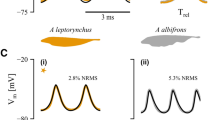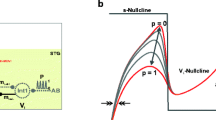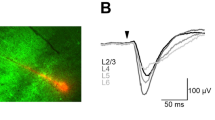Abstract
The pacemaker nucleus of Gymnotus carapo contains two types of neurons: pacemaker cells which set up the frequency of the electric organ discharge (EOD) and relay cells which convey the command signal to the spinal cord. Direct activation of a single relay cell provides enough excitation to discharge a pool of spinal electromotor neurons and electrocytes, generating a small EOD (unit EOD). Different relay cells generate unit EODs of variable size and waveform, indicating the involvement of different groups of electrocytes. A special technique of EOD recording (multiple air-gap) was combined with intracellular stimulation of relay cells to study the spatial distribution within the electric organ (EO) of the command signal arising from different relay cells. Three types of relay cells could be identified: type I commanding the rostral 10% of the EO, type II which distribute their command all along the EO and type III driving the caudal 30%. Waveform analysis of unit EODs indicates that doubly innervated electrocytes which are the most relevant for attaining the specific EOD waveform, receive a favored command from the pacemaker nucleus.
Similar content being viewed by others
Abbreviations
- CV:
-
conduction velocity
- EMF:
-
electromotive force
- EMN:
-
electromotor neuron
- EO:
-
electric organ
- EOD:
-
electric organ discharge
- PN:
-
pacemaker nucleus
- uEOD:
-
unit electric organ discharge
References
Bastian J (1986) Electrolocation: behavior, anatomy and physiology. In: Bullock TH, Heiligenberg W (eds) Electroreception. Wiley, New York, pp 577–612
Bennett MVL (1971) Electric organs. In: Hoar WS, Randall DJ (eds) Fish physiology. Academic Press, New York, pp 347–491
Bennett MVL, Grundfest H (1959) Electrophysiology of the electric organ in Gymnotus carapo. J Gen Physiol 42:1067–1104
Bennett MVL, Pappas GD, Giménez M, Nakajima Y (1967) Physiology and ultrastructure of electrotonic juctions. IV. Medullary electromotor nuclei in gymnotid fish. J Neurophysiol 30:236–300
Caputi A, Macadar O, Trujillo-Cenóz (1989) Waveform generation of the electric organ discharge in Gymnotus carapo. III. Analysis of the fish body as an electric source. J Comp Physiol A 165:361–370
Caputi A, Silva A, Macadar O (1993) Electric organ activation in Gymnotus carapo: Spinal origin and peripheral mechanisms. J Comp Physiol A 173:227–232
Ellis D, Szabo T (1980) Identification of different cell types in the command pacemaker nucleus of several Gymnotiform species by retrograde transport of horseradish peroxidase. Neuroscience 5:1917–1929
Hagedorn M, Carr C (1985) Single electrocytes produce a sexually dimorphic signal in South American electric fish Hypopomus occidentalis (Gymnotiformes, Hypopomidae). J Comp Physiol A 156:511–533
Henneman E (1965) Functional significance of cell size in spinal motoneurons. J Neurophysiol 28:560–580
Hopkins C (1972) Sex differences in electric signaling in an electric fish. Science 176:1035–1037
Hopkins C (1980) Evolution of electric communication channels of Mormyrids. Behav Ecol Sociobiol 7:1–13
Lissmann H, Machin N (1958) The mechanism of object location in Gymnarchus niloticus and similar fish. J Exp Biol 35:451–486
Lloyd DPC (1943) Reflex action in relation to pattern and peripheral source of afferent stimulation. J Neurophysiol 6: 111–119
Lorenzo D, Velluti JC, Macadar O (1988) Electrophysiological properties of abdominal electrocytes in the weakly electric fish Gymnotus carapo. J Comp Physiol A 162:141–144
Lorenzo D, Sierra F, Silva A, Macadar O (1990) Spinal mechanims of electric organ discharge synchronization in Gymnotus carapo. J Comp Physiol A 167:447–452
Lorenzo D, Sierra F, Silva A, Macadar O (1991) Electrogénesis en Gymnotus carapo: un pez de descarga débil. XVII Congreso Latinoamericano de Ciencias Fisiologicas. La Habana, Cuba
Macadar O, Lorenzo D, Velluti JC (1989) Waveform generation of the electric organ discharge in Gymnotus carapo. II. Electrophysiological properties of single electrocytes. J Comp Physiol A 165:353–360
Sherrington CS (1906) The integrative action of the nervous system. New Haven, London
Szabo T (1961) Anatomophisiologie des centres nerveux de quelques organes électriques. In: Chagas C, Paes de Carvalho A (eds) Bioelectrogenesis. Elsevier, Amsterdam, pp 185–201
Trujillo-Cenóz O, Echagüe JA (1989) Waveform generation of the electric organ discharge in Gymnotus carapo. I. Morphology and innervation of the electric organ. J Comp Physiol A 165:343–351
Trujillo-Cenóz O, Echagüe JA, Macadar O (1984) Innervation pattern and electric organ discharge waveform in Gymnotus carapo (Teleostei, Gymnotiformes). J Neurobiol 15:273–284
Trujillo-Cenóz O, Echagüe JA, Bertolotto C, Lorenzo D (1986) Some aspects of the structural organization of the spinal cord of Gymnotus carapo (Teleostei, Gymnotiformes). I. The electromotorneurons. J Ultrastruct Molec Struct Res 97:130–143
Author information
Authors and Affiliations
Rights and permissions
About this article
Cite this article
Lorenzo, D., Sierra, F., Silva, A. et al. Spatial distribution of the medullary command signal within the electric organ of Gymnotus carapo . J Comp Physiol A 173, 221–226 (1993). https://doi.org/10.1007/BF00192980
Accepted:
Issue Date:
DOI: https://doi.org/10.1007/BF00192980




